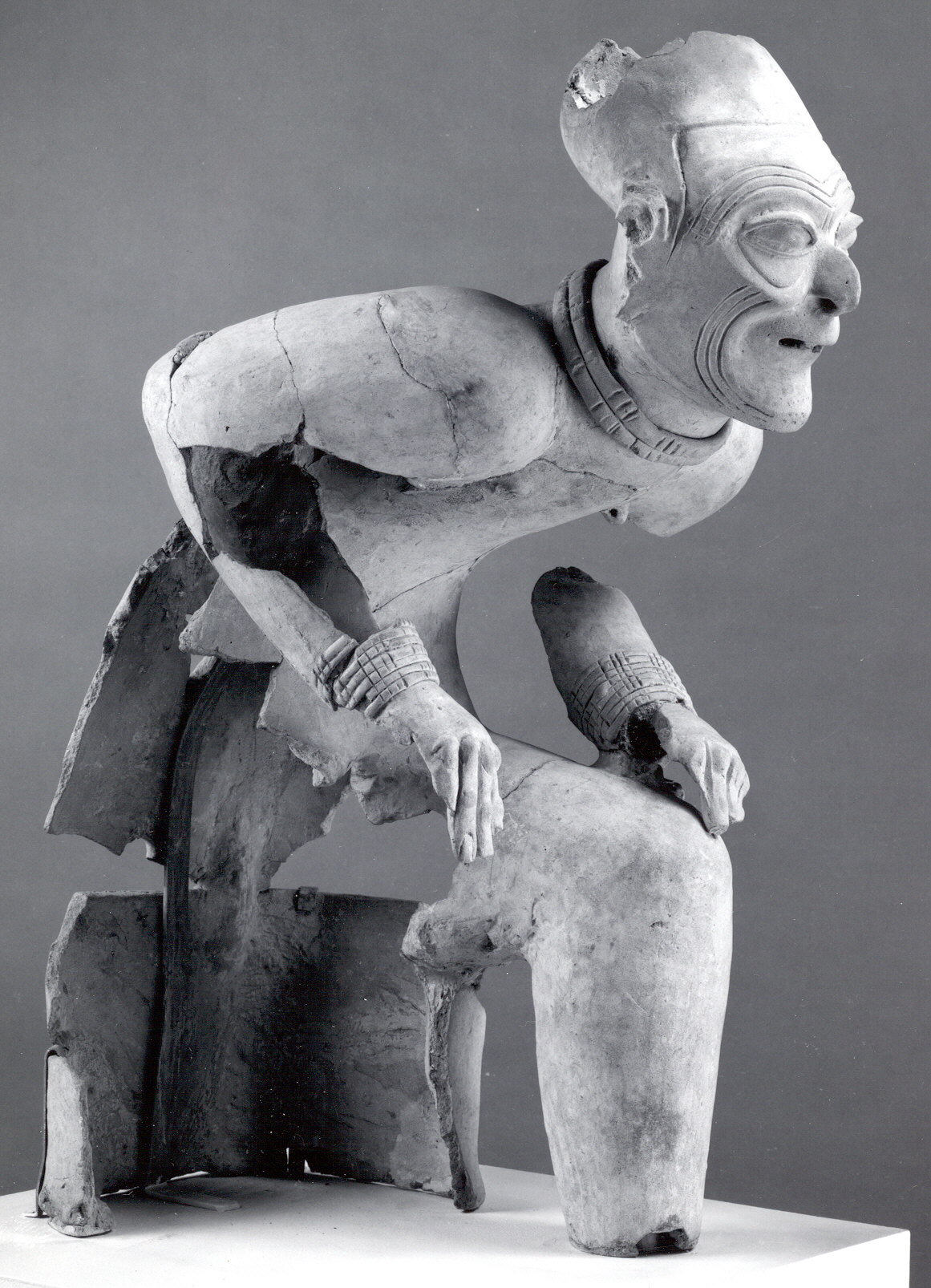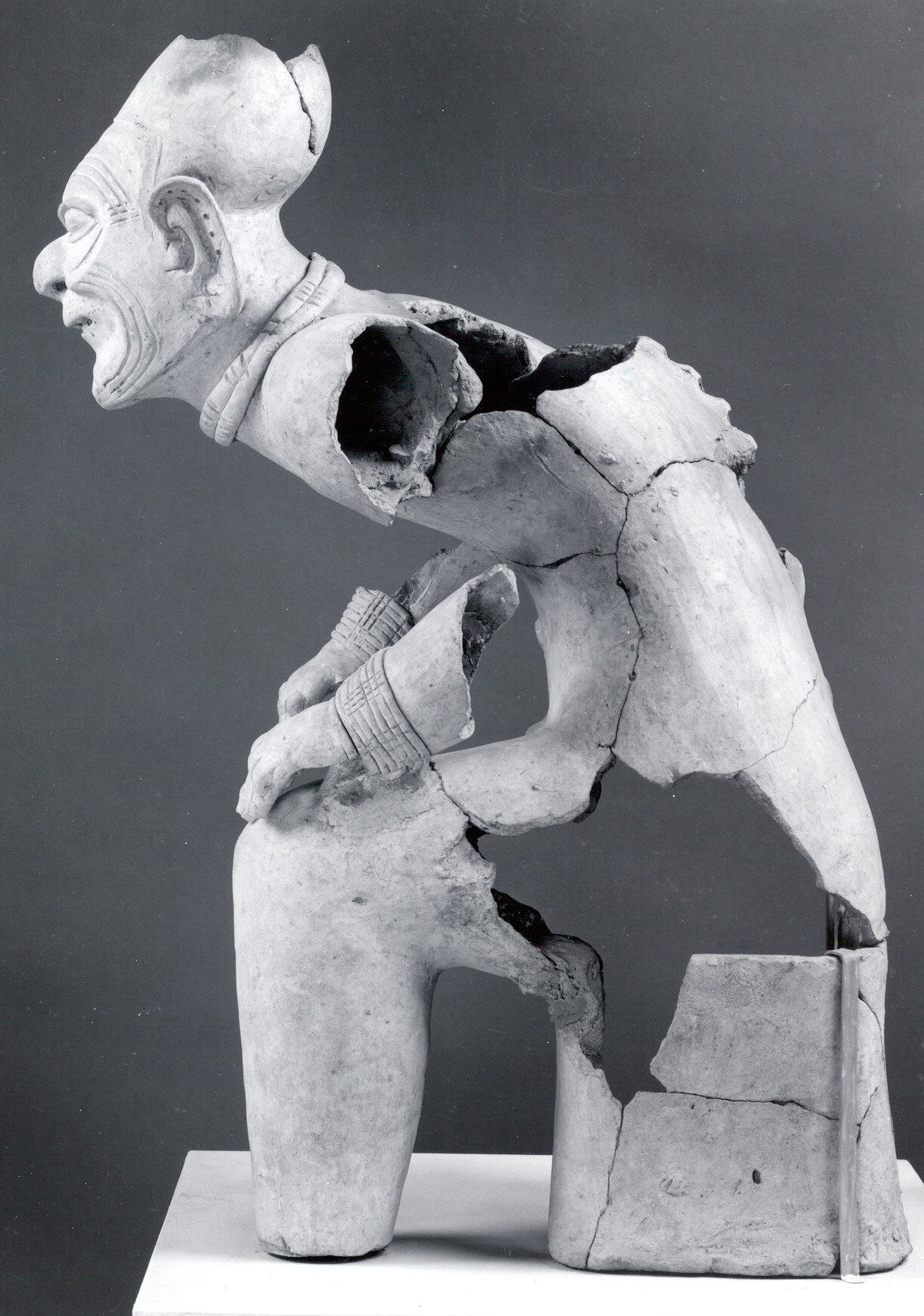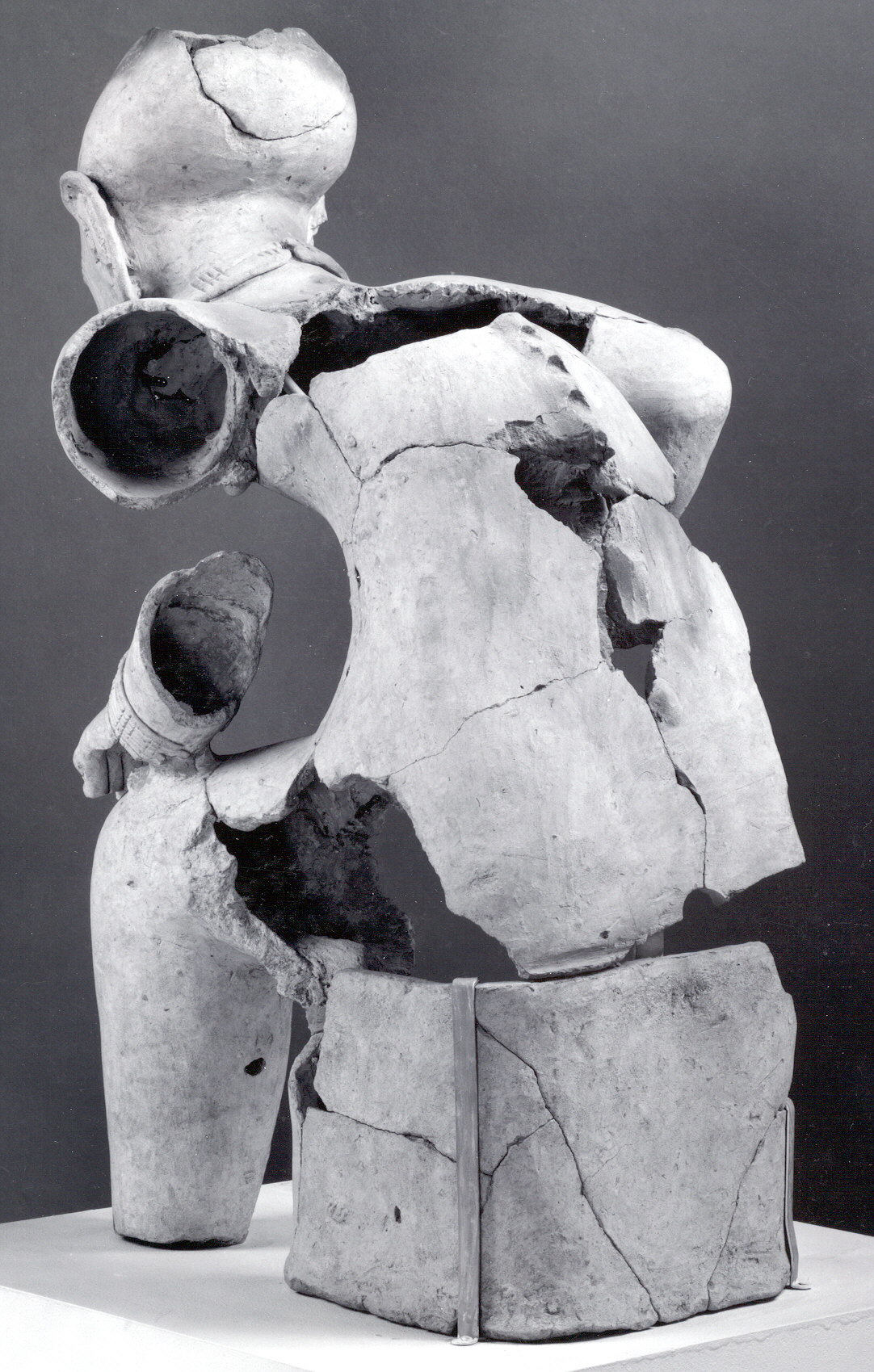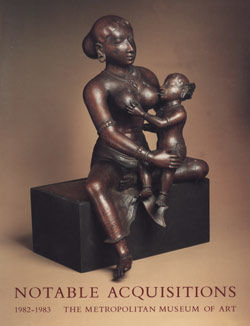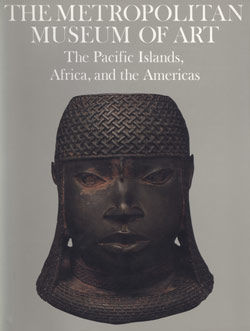Seated elder
Not on view
This sculpture is one of the most spectacular examples of ceramic figures created by Tolita-Tumaco artists. It depicts an elderly person, recognizable by facial wrinkles, baggy skin beneath the eyes, the few remaining teeth, and chin stubble. Its flattened head reveals cranial modification during childhood, a cultural practice that could have signaled ethnic identity or rank in antiquity. The gender of this effigy is not clear. Marked nipples, as in this figure’s chest, were more common in female than male representations in Tolita-Tumaco and Jama-Coaque ceramic traditions of coastal Ecuador. This statue, however, lacks the long skirts that are typically seen in female images.
The artist(s) would have taken several days to complete the sculpture due to the complexity of the body and the weight of the moist clay. This figure was crafted using the gray clay paste that characterizes Tolita-Tumaco ceramics. The torso was shaped most likely using clay slabs that were gradually added until completing the final form. The limbs and the head were made separately and attached to the torso before drying and firing. A one-side mold was used for the face while the wrinkles and other details were incised when the clay paste was still soft. Today’s monochromatic and matte appearance of these sculptures is the result of wear. Apparently, many of these objects had a smooth and polished finish and were decorated with post-fired paints (see Valdez 1992:136; MMA 1991.436.7a, b), in a similar fashion to Jama-Coaque sculptures (MMA 1980.34.38a, MMA 1980.34.39).
A careful examination of the lower back shows that this figure may have been seated on a stool (compare with MMA 1991.436.7a, b). Elaborate stone or wood seats were important symbols of authority in the ancient Americas, from Ecuador to Mesoamerica, including the Amazonian and the Caribbean areas (McEwan and Looper 2021). The relatively high rank or importance of this individual is also suggested by the collar and bracelets modeled in clay. Adornments, probably made of gold, originally hung from holes on its nose, ears, and nipples (see MMA 1979.206.1204 and 1979.206.1136).
Tolita-Tumaco potters are known for their realistic renderings of humans, such as the examples in the collections of Casa de Alabado in Quito (Cruz Cevallos 1992:225) and Museo Chileno de Arte Precolombino in Santiago (MCHAP 0348). Some of their figures are depicted leaning forward, adopting an animated pose, with flexed legs, arched torsos, and faces staring ahead. Elders were a popular theme, and several examples can be found in the collections of the Museo del Banco Central de Ecuador in Quito (No. 12-53-69, LT-2-16-69, LT-3-11-70) and in Guayaquil (GA-1-2268-82, GA-5-1631-80). A common interpretation is that these elder figures were representations of religious specialists, or ancient "shamans" who had the responsibility to mediate relations between people and other beings in nature. The marked spine in the back may be revealing of more than a very lean body, as it bears a resemblance to iguanas (compare with a Bahia example of iguanas: MMA 1988.117.7). With dry and wrinkled skin, the comparison of Tolita-Tumaco revered elders with those reptiles could have been a way to evoke the human-animal connection that is a key element in shamanistic rituals.
Tolita-Tumaco was a civilization that flourished on the tropical Pacific coast of northern Ecuador and southern Colombia. In a landscape shaped by the rivers, with swampy mangroves, and hills covered in dense forests, these communities settled in large villages organized around plazas and several massive earthen mounds, known as tolas, that were the residences and burials of the elite. Remains of these human and animal sculptures have been found in settlements and cemeteries, but their original use remains unknown. The Tolita-Tumaco tradition started around 600 B.C., but its distinctive style matured between 200 B.C. and A.D. 400. During these centuries, these communities produced one of the most refined metalwork traditions in the ancient Americas and established relationships with other communities on the Pacific coast, including those in Northern Peru.
Hugo C. Ikehara-Tsukayama, Andrew W. Mellon Curatorial/Collection Specialist Fellow, Arts of the Ancient Americas, 2022.
References and further reading
Burtenshaw, Julia, Héctor García Botero, Diana Magaloni, and María Alicia Uribe Villegas (eds.). The Portable Universe/El universo en tus manos: Thought and Splendor of Indigenous Colombia. Los Angeles/New York: Los Angeles County Museum of Art, DelMonico Books, 2022.
Cruz Cevallos, Iván. El mundo de los espíritus en el Ecuador precolombino. Milan: 5 Continents, 2012.
Cummins, Tom. "Tradition in Ecuadorian Pre-Hispanic Art," in Amerindian Signs: 5.000 Years of Precolumbian Art in Ecuador, edited by Francisco Valdez and Diego Veintimilla, pp. 63-81. Quito: Colibrí editions, 1992.
McEwan, Colin, and Matthew Looper. "Seats, Seating, and Social roles: Cross-cultural Comparisons," in: Pre-Columbian Central America, Colombia, and Ecuador: Toward an Integrated Approach, edited by Colin McEwan and John W. Hoopes, pp. 377-407. Washington, D.C.: Dumbarton Oaks Research Library and Collection, 2021.
Patiño, Diógenes. Tumaco prehispánico: Asentamiento, subsistencia e intercambio en la costa pacífica de Colombia. Popayán, Colombia: Editorial Universidad del Cauca, 2003.
Scott, David A. "The La Tolita-Tumaco Culture: Master Metalsmiths in Gold and Platinum." Latin American Antiquity Vol. 22, No 1 (2011):65-95.
Ugalde, María Fernanda. Iconografía de la cultura Tolita: Lecturas del discurso ideológico en las representaciones figurativas del Desarrollo Regional. Forschungen zur Archäologie Außereuropäischer Kulturen Band 7. Deutsches Archäologisches Institut. Wiesbaden: Reichert Verlag, 2009.
Ugalde, María Fernanda. "Las alfareras rebeldes: una mirada desde la arqueología ecuatoriana a las relaciones de género, la opresión femenina y el patriarcado." Antípoda. Revista de antropología y arqueología No 36 (2019):33-56.
Valdez, Francisco. "The Tolita Ceramic Tradition," in Amerindian Signs: 5.000 Years of Precolumbian Art in Ecuador, edited by Francisco Valdez and Diego Veintimilla, pp. 135-40. Quito: Colibrí editions, 1992.
#1615. Seated Figure
Due to rights restrictions, this image cannot be enlarged, viewed at full screen, or downloaded.
This artwork is meant to be viewed from right to left. Scroll left to view more.


